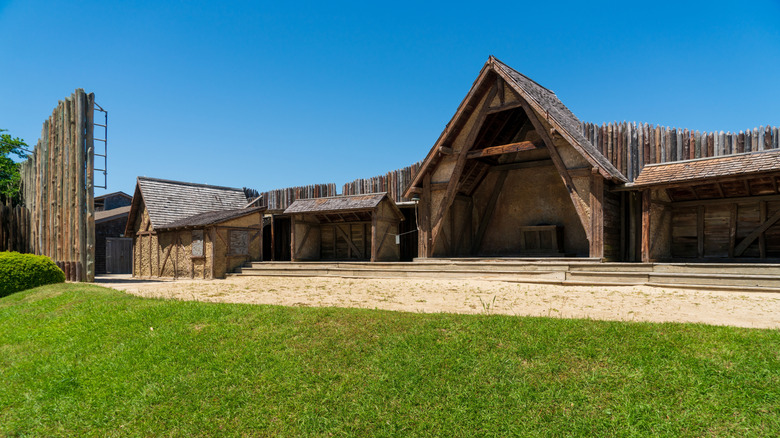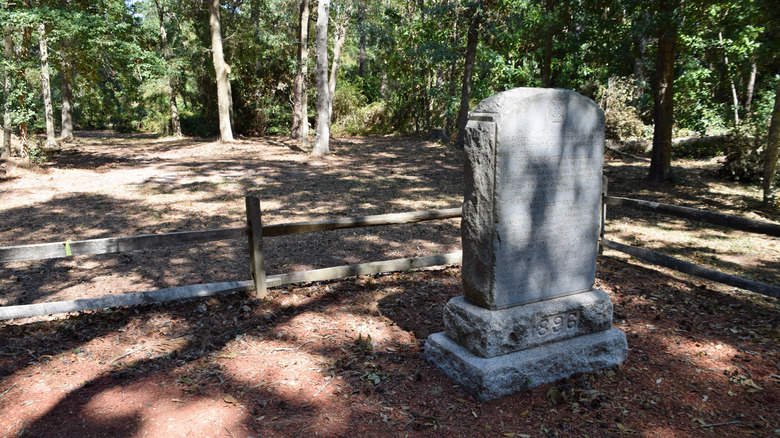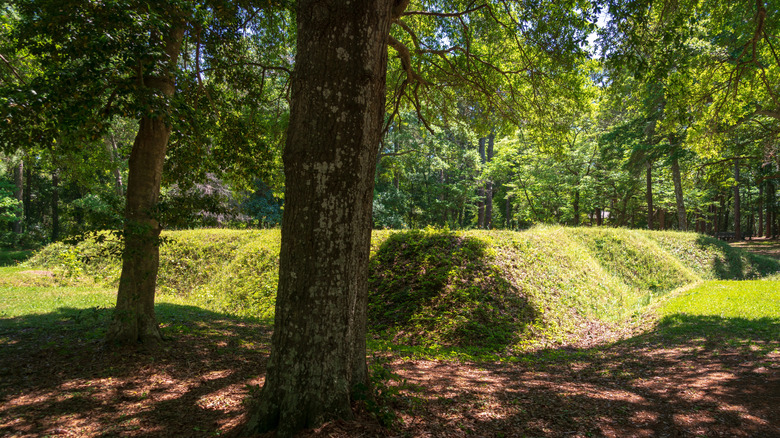North Carolina's Historic Fort Raleigh Site Offers Beautiful Trails And A Beach With Dazzling Views
From the Great Smoky Mountains to the gorgeous Outer Banks coastline, North Carolina has long held its reputation as a top outdoor destination on the East Coast. However, as one of the original 13 colonies of the United States, North Carolina also has plenty of historical significance. North Carolina's history as an English colony extends back into the late 16th century, with some of the earliest European settlements in what would eventually become the United States. Today, you can find plenty of excellent North Carolina attractions that keep this history alive. For example, you can witness the past come to life at the "living history" displays on Roanoke Island's Island Farm. And for the most comprehensive historical immersion in North Carolina, you don't need to travel far on Roanoke Island to discover the amazing Fort Raleigh National Historic Site.
The landmark is a 16th-century relic that preserves much of Roanoke Island's colonial heritage, including invaluable historical buildings and informative exhibits. Fort Raleigh's history also extends beyond its initial colonization attempts, through the past few centuries of American history, and Fort Raleigh National Historic Site showcases this complex and engaging historical tapestry. And if you're not a huge history buff, Fort Raleigh also features some lovely hiking trails, plus access to one of the best beaches in North Carolina's acclaimed Outer Banks!
Fort Raleigh is one of America's oldest and most important historical sites
If the name "Roanoke" sounds familiar, that's because it's the setting of America's first — and, arguably, most baffling — historical mystery. Way back in 1585, Roanoke Island was the site of the first attempt at an English settlement in the New World. Of course, the word "attempt" should clue you in on how successful it was. But the Roanoke Colony didn't just fail; it disappeared completely.
In 1590, the colony's governor, John White, returned to Roanoke after a lengthy supply trip to England. What he found there was the colony entirely deserted, with no sign of life (and, notably, no sign of a struggle). The only clue to the colonists' whereabouts was the word "CROATOAN" carved into a palisade. White assumed this signified the colonists had evacuated to the nearby Croatoan Island. However, a sudden storm prevented him from investigating Croatoan, and he was forced to return to England with no answers. Today, the ultimate fate of the more than 100 colonists remains a mystery.
The Fort Raleigh National Historic Site now serves as a living museum of this historically significant area, complete with restored earthworks dating back to the original Roanoke Colony in 1585. The park also features an educational museum filled with Colonial-era artifacts and several historic trails. But the history of Roanoke Island doesn't begin and end with its lost colony. For centuries before the English arrived, the island was home to Native American tribes, including the Carolina Algonquin. Later, in the 19th century, the island was home to a Freedmen's colony, where newly freed African Americans took refuge during the Civil War. The Fort Raleigh National Historic Site keeps these additional stories alive through exhibits, historical trails, and ranger-led educational programs.
The Fort Raleigh National Historic Site is also a great stop for outdoor recreation
With such an impressive historical pedigree, Fort Raleigh National Historic Site is a perfect destination for history buffs. Much like the historic maritime museum at the Chicamacomico Life-Saving Station in Rodanthe, Fort Raleigh provides a comprehensive guide to the region's long and complex history. But even if you don't care that much about history, Fort Raleigh is still an exceptional Outer Banks outdoor destination. The park's Freedom Trail provides a scenic tour of the many historical sites, while the Thomas Hariot Nature Trail is a short but sweet excursion through the park's lovely natural setting.
The park even features an elaborate Elizabethan Gardens site, modeled after the royal gardens of Elizabethan-era England. And despite its status as a "historic site," Fort Raleigh also boasts one of the best beaches in the Outer Banks. The wonderful Etheridge Point Beach offers excellent swimming opportunities while also providing views of iconic Outer Banks sites like Jockey's Ridge, Colington Island, and the Wright Brothers Monument. Each night between May and August, the park's Waterside Theatre hosts the thrilling "The Lost Colony" play, portraying the tale of the Lost Colony of Roanoke in a family-friendly night of entertainment.
Fort Raleigh National Historic Site is located in Manteo, North Carolina. Even without its historical ties, Manteo is famed as the "Heart of Roanoke Island" with its cozy B&Bs and tasty cuisine. While Fort Raleigh doesn't have camping sites, the surrounding Outer Banks have plenty of amazing campgrounds and RV parks, plus more modern lodging options, including townhouses and cottages, if camping isn't your thing. Thanks to the Chesapeake Expressway, Fort Raleigh is only about two hours away from Norfolk, Virginia, and nearby attractions such as Virginia Beach.


